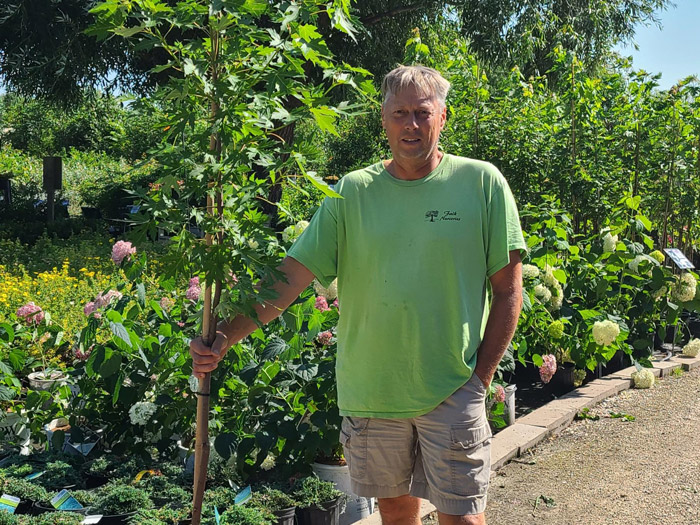This tree is almost native to Manitoba. In my tree exploration travels I have found Silver Maples growing wildly very near to home. Crossing the border at Sprague on the way to Ontario, the first Ontario town you come to is Rainy River. When you follow the River on the American side you will see Silver Maples growing naturally along the bank.
I’ll be honest this tree has still left me with some puzzles. I suspect it all boils down to where the tree is from originally. It is native across most of the eastern states and well into central USA. Here in the Red River Valley, it does not seem to tolerate soggy soil. Yet in Ontario I have seen its roots fully submersed in the Rainy River. It could be our clay does not allow it to breathe. It could also be that the trees we have are genetically different. They could be from the central northern states and be much more drought tolerant.
Another challenge for the Silver Maple in the Red River Valley is the high pH. Trees from Eastern America are growing primarily in acidic soil, ours is alkaline. You will see many Silver Maples in the Northwest end of Winnipeg that are quite yellow throughout the season. We could rename those Golden Maples not Silver Maples. The truth is they are stressed out and anemic. That really does not sound Golden to me. It is difficult to do a soil test to know exactly what you have because our soil changes so radically from place to place. I’ve even seen a tree with green healthy leaves on one side and yellow on the other because the soil the tree is on is different on each side. Wild right? This can happen when we trench and move deep heavy clay up to the surface as well.
If you really want to know if your area has high pH. Look at what is growing there already. If Poplar, Willows, Amur maple, Mountain Ash, Plums or Apples have yellowish leaves with green veins that is a telltale sign of high ph.
Don’t throw in the towel though, there are many successful Silver Maples growing in our province. It’s not that they need to be planted in highly acidic soil. It’s just their tolerance is lower than trees like Green Ash, Manitoba Maples, or Elms.
Some Silver Maples have a susceptibility to leaf gaul. This is a mostly cosmetic concern as there are bumps that will form on the leaves, were insects have burrowed. I have seen one tree with it and the one beside it has nothing.
All this aside Silver Maples do have several positive attributes. First of all, they are fast growing. Secondly, they have a nicely rounded crown creating lovely, filtered shade. They have the traditional Maple leaf that is always beautiful. The backside of a leaf has a silverish tone, thus its name. This is not to be confused with Silver Poplars however, which is a marginally hardy heavily suckering tree. Silver Maple is far more cut leafed than the Poplar and has a more broadly branched shade tree structure. Silver Maples also do not sucker but they do have a large root system so it should not be planted near sidewalks, driveways, or foundations.
I would plant it 10-15 ft from a driveway or sidewalk and more like 25-30 ft from a house foundation. I would treat silver maple as a front or back yard tree, possibly a park tree. Is not sufficiently Hardy or soil tolerant enough to be highly recommended as a shelter belt tree unless you have moist, well-drained, lighter soil. I would categorize it similarly to Linden in its requirements for reasonable shelter and drainage yet subsidized moisture during droughts.
There are many good trees and Silver Maple is definitely one of them. It’s just that every tree has its own unique requirements. There are no perfect trees. If you can match up a tree that works for your interests and environment that’s the best scenario.




